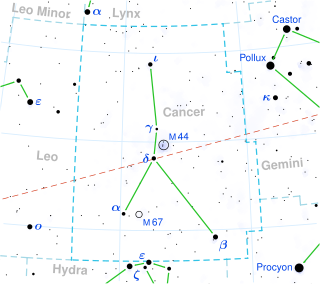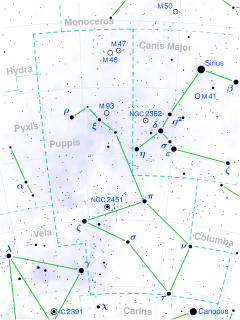Related Research Articles

Epsilon Cancri is a white-hued binary star system in the zodiac constellation of Cancer. It is the brightest member of the Beehive Cluster with an apparent visual magnitude of +6.29, which is near the lower limit of visibility with the naked eye. The annual parallax shift of 5.4 mas as seen from Earth yields a distance estimate of approximately 606 light-years from the Sun.

63 Andromedae is an Alpha2 Canum Venaticorum variable star in the constellation Andromeda. Its variable star designation is PZ Andromedae. With an apparent magnitude of about 5.6, it is bright enough to be seen by naked eye. Based upon an annual parallax shift of 8.53 mas, it is located 382 light years away.
24 Cancri is a triple star system in the constellation Cancer. The system is located about 226 light-years away, based on its parallax. The system has a combined apparent magnitude of 6.5, and the two components A and B are separated by 5.7″.
HD 4113 is a dual star system in the southern constellation of Sculptor. It is too faint to be viewed with the naked eye, having an apparent visual magnitude of 7.88. The distance to this star, as estimated by parallax measurements, is 137 light years. It is receding away from the Sun with a radial velocity of +5 km/s.
HD 115404 is a binary star system located in the constellation Coma Berenices. Parallax measurements made by Hipparcos put the system at 36 light-years, or 11 parsecs, away. The combined apparent magnitude of the system is 6.52, with the magnitudes of the components being 6.66 and 9.50.
HD 88836, also known as HR 4019, is a solitary, yellow-hued star located in the southern constellation Antlia. It has an apparent magnitude of 6.32, placing it near the limit for naked eye visibility. Based on an annual parallax shift of 7.019 mas, the object is estimated to be 465 light years away from the Solar System. Its distance from the Sun does not appear to be changing, having a radial velocity of 0 km/s.
LP Aquarii is a pulsating variable star in the constellation of Aquarius that varies between magnitudes 6.30 and 6.64. The position of the star near the ecliptic means it is subject to lunar occultations.

HD 135530 is a suspected variable star in the northern constellation of Boötes.
HD 90089 is a star located in the northern circumpolar constellation Camelopardalis. With an apparent magnitude of 5.25, it is faintly visible to the naked eye under ideal conditions. This star is located relatively close at a distance of 75 light years, but is drifting away at a rate of almost 8 km/s.

Iota Trianguli, Latinized from ι Trianguli, is a quadruple star system in constellation of Triangulum. The pair have a combined apparent magnitude of 4.95 and are approximately 290 light years from Earth.

1 Puppis is a single star in the southern constellation of Puppis. It lies in the northern part of the constellation at a distance of about 790 ly, east of Aludra in Canis Major and just north of the white supergiant, 3 Puppis. This object is visible to the naked eye as a faint, red-hued star with an apparent visual magnitude of 4.59. It is moving further from the Earth with a heliocentric radial velocity of +32.4 km/s.
57 Persei, or m Persei, is a suspected triple star system in the northern constellation of Perseus. It is at the lower limit of visibility to the naked eye, having a combined apparent visual magnitude of 6.08. The annual parallax shift of 16.4 mas provides a distance measure of 199 light years. 57 Persei is moving closer to the Sun with a radial velocity of about −23 km/s and will make perihelion in around 2.6 million years at a distance of roughly 22 ly (6.6 pc).

31 Cygni, also known as ο1 Cygni, Omicron1 Cygni, or V695 Cygni, is a triple star system about 750 light years away in the constellation Cygnus.
HD 82514, also known as HR 3790, is a solitary, orange-hued star located in the southern constellation Antlia. It has an apparent magnitude of 5.86, allowing it to be faintly seen with the naked eye. Based on parallax measurements from the Gaia spacecraft, it is estimated to be 279 light years away from the Solar System. However, it is receding with a heliocentric radial velocity of 14.3 km/s.

Iota Mensae is a single star about 880 light years away in the faint constellation Mensa. It has a very slightly variable apparent magnitude of 6.0, making it visible with the naked eye under good skies.
HD 76270, also known as HR 3544, is a solitary, white hued star located in the southern circumpolar constellation Volans. It has an apparent magnitude of 6.10, making it faintly visible to the naked eye if viewed under ideal conditions. The object is relatively far with a distance of 2,360 light years, but is slowly approaching the Solar System with a heliocentric radial velocity of −2.6 km/s.
HD 37289, also known as HR 1916, is a solitary, orange hued star located in the northern circumpolar constellation Camelopardalis. It has an apparent magnitude of 5.61, making it faintly visible to the naked eye under ideal conditions. Based on parallax measurements from the Gaia spacecraft, the object is estimated to be 308 light years distant. It appears to be approaching the Sun, having a heliocentric radial velocity of −20.7 km/s.

72 Tauri is a possible binary star in the zodiac constellation of Taurus. It is faintly visible to the naked eye with an apparent visual magnitude of +5.5, although only 0.29° from the brighter υ Tauri. Based upon an annual parallax shift of 7.9 mas seen from Earth, it is around 410 light years from the Sun.
6 Tauri, also designated t Tauri, is a chemically peculiar star in the northern constellation of Taurus. It has an apparent visual magnitude of 5.8, so, according to the Bortle scale, it is faintly visible from suburban skies at night. Measurements made with the Gaia spacecraft show an annual parallax shift of 9.0 mas, which is equivalent to a distance of around 363 light years from the Sun.
7 Tauri is a multiple star in the northern constellation of Taurus. It has a combined apparent visual magnitude of 5.95, so, according to the Bortle scale, it is faintly visible from suburban skies at night. Measurements made with the Gaia spacecraft show an annual parallax shift of 5.5 mas, which is equivalent to a distance of around 593 light years from the Sun.
References
- 1 2 3 4 5 6 7 8 9 10 11 Vallenari, A.; et al. (Gaia Collaboration) (2022). "Gaia Data Release 3. Summary of the content and survey properties". Astronomy & Astrophysics . arXiv: 2208.00211 . doi: 10.1051/0004-6361/202243940 . Gaia DR3 record for this source at VizieR.
- ↑ Høg, E.; et al. (2000), "The Tycho-2 catalogue of the 2.5 million brightest stars", Astronomy & Astrophysics, 355: L27–L30, Bibcode:2000A&A...355L..27H.
- 1 2 3 4 5 6 7 8 9 10 11 Vallenari, A.; et al. (Gaia Collaboration) (2022). "Gaia Data Release 3. Summary of the content and survey properties". Astronomy & Astrophysics . arXiv: 2208.00211 . doi: 10.1051/0004-6361/202243940 . Gaia DR3 record for this source at VizieR.
- ↑ Fabricius, C; Høg, E; Makarov, V. V; Mason, B. D; Wycoff, G. L; Urban, S. E (2002). "The Tycho double star catalogue". Astronomy and Astrophysics. 384: 180–189. Bibcode:2002A&A...384..180F. doi: 10.1051/0004-6361:20011822 .
- 1 2 Abt, H. A. (1981). "Visual multiples. VII. MK classifications". The Astrophysical Journal Supplement Series. 45: 437. Bibcode:1981ApJS...45..437A. doi:10.1086/190719.
- 1 2 3 Renson, P.; Manfroid, J. (May 2009), "Catalogue of Ap, HgMn and Am stars", Astronomy and Astrophysics, 498 (3): 961–966, Bibcode:2009A&A...498..961R, doi: 10.1051/0004-6361/200810788 .
- ↑ de Bruijne, J. H. J.; Eilers, A.-C. (October 2012), "Radial velocities for the HIPPARCOS-Gaia Hundred-Thousand-Proper-Motion project", Astronomy & Astrophysics, 546: 14, arXiv: 1208.3048 , Bibcode:2012A&A...546A..61D, doi:10.1051/0004-6361/201219219, S2CID 59451347, A61.
- 1 2 3 4 Anders, F.; Khalatyan, A.; Queiroz, A. B. A.; Chiappini, C.; Ardevol, J.; Casamiquela, L.; Figueras, F.; Jimenez-Arranz, O.; Jordi, C.; Monguio, M.; Romero-Gomez, M.; Altamirano, D.; Antoja, T.; Assaad, R.; Cantat-Gaudin, T.; Castro-Ginard, A.; Enke, H.; Girardi, L.; Guiglion, G.; Khan, S.; Luri, X.; Miglio, A.; Minchev, I.; Ramos, P.; Santiago, B. X.; Steinmetz, M. (2022). "VizieR Online Data Catalog: StarHorse2, Gaia EDR3 photo-astrometric distances (Anders+, 2022)". Vizier Online Data Catalog. Bibcode:2022yCat.1354....0A.
- ↑ Zorec, J.; Royer, F. (2012). "Rotational velocities of A-type stars". Astronomy & Astrophysics. 537: A120. arXiv: 1201.2052 . Bibcode:2012A&A...537A.120Z. doi:10.1051/0004-6361/201117691. S2CID 55586789. Vizier catalog entry
- 1 2 "BD+42 41B". SIMBAD . Centre de données astronomiques de Strasbourg . Retrieved 15 February 2014.
- ↑ McAlister, H. A.; et al. (1989). "ICCD speckle observations of binary stars. IV - Measurements during 1986-1988 from the Kitt Peak 4 M telescope". The Astronomical Journal. 97: 510. Bibcode:1989AJ.....97..510M. doi:10.1086/115001.